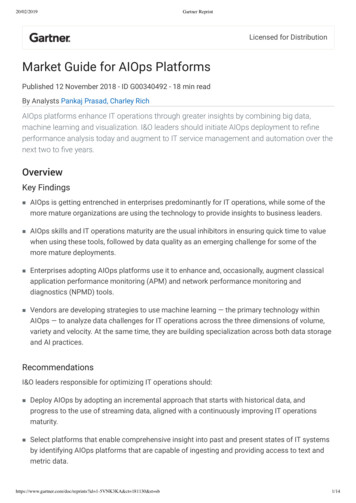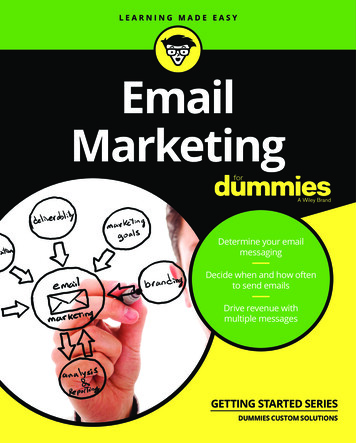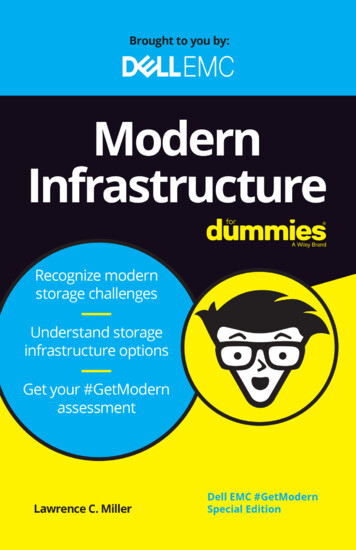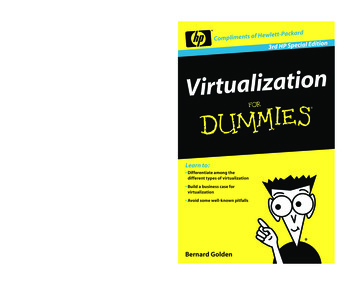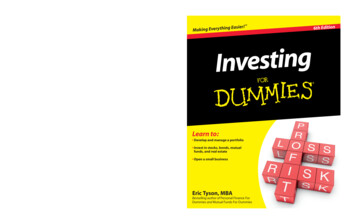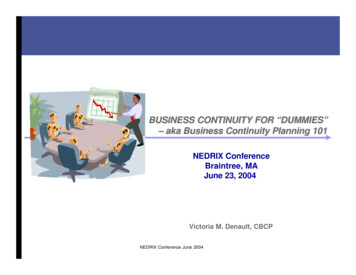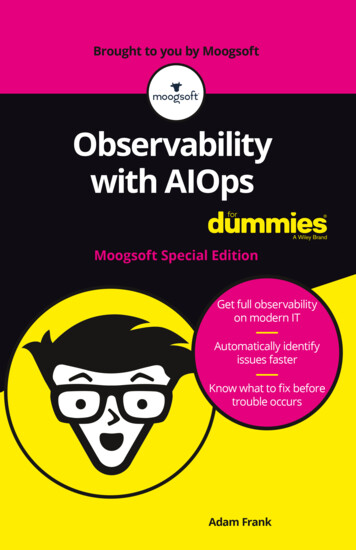
Transcription
Observabilitywith AIOpsMoogsoft Special Editionby Adam FrankThese materials are 2020 John Wiley & Sons, Inc. Any dissemination, distribution, or unauthorized use is strictly prohibited.
Observability with AIOps For Dummies , Moogsoft Special EditionPublished byJohn Wiley & Sons, Inc.111 River St.Hoboken, NJ 07030-5774www.wiley.comCopyright 2020 by John Wiley & Sons, Inc., Hoboken, New JerseyNo part of this publication may be reproduced, stored in a retrieval system or transmitted in anyform or by any means, electronic, mechanical, photocopying, recording, scanning or otherwise,except as permitted under Sections 107 or 108 of the 1976 United States Copyright Act, without theprior written permission of the Publisher. Requests to the Publisher for permission should beaddressed to the Permissions Department, John Wiley & Sons, Inc., 111 River Street, Hoboken, NJ07030, (201) 748-6011, fax (201) 748-6008, or online at http://www.wiley.com/go/permissions.Trademarks: Wiley, For Dummies, the Dummies Man logo, The Dummies Way, Dummies.com,Making Everything Easier, and related trade dress are trademarks or registered trademarks ofJohn Wiley & Sons, Inc. and/or its affiliates in the United States and other countries, and may notbe used without written permission. Moogsoft, the Moogsoft logo, Moogsoft AIOps, MoogsoftEnterprise, and Moogsoft Express are trademarks belonging to Moogsoft (Herd), Inc., and cannotbe used without written permission. All other trademarks are the property of their respective owners.John Wiley & Sons, Inc., is not associated with any product or vendor mentioned in this book.LIMIT OF LIABILITY/DISCLAIMER OF WARRANTY: THE PUBLISHER AND THE AUTHOR MAKE NOREPRESENTATIONS OR WARRANTIES WITH RESPECT TO THE ACCURACY OR COMPLETENESS OFTHE CONTENTS OF THIS WORK AND SPECIFICALLY DISCLAIM ALL WARRANTIES, INCLUDINGWITHOUT LIMITATION WARRANTIES OF FITNESS FOR A PARTICULAR PURPOSE. NO WARRANTYMAY BE CREATED OR EXTENDED BY SALES OR PROMOTIONAL MATERIALS. THE ADVICEAND STRATEGIES CONTAINED HEREIN MAY NOT BE SUITABLE FOR EVERY SITUATION. THISWORK IS SOLD WITH THE UNDERSTANDING THAT THE PUBLISHER IS NOT ENGAGED INRENDERING LEGAL, ACCOUNTING, OR OTHER PROFESSIONAL SERVICES. IF PROFESSIONALASSISTANCE IS REQUIRED, THE SERVICES OF A COMPETENT PROFESSIONAL PERSON SHOULD BESOUGHT. NEITHER THE PUBLISHER NOR THE AUTHOR SHALL BE LIABLE FOR DAMAGES ARISINGHEREFROM. THE FACT THAT AN ORGANIZATION OR WEBSITE IS REFERRED TO IN THIS WORKAS A CITATION AND/OR A POTENTIAL SOURCE OF FURTHER INFORMATION DOES NOT MEANTHAT THE AUTHOR OR THE PUBLISHER ENDORSES THE INFORMATION THE ORGANIZATIONOR WEBSITE MAY PROVIDE OR RECOMMENDATIONS IT MAY MAKE. FURTHER, READERSSHOULD BE AWARE THAT INTERNET WEBSITES LISTED IN THIS WORK MAY HAVE CHANGED ORDISAPPEARED BETWEEN WHEN THIS WORK WAS WRITTEN AND WHEN IT IS READ.ISBN 978-1-119-73528-1 (pbk); ISBN 978-1-119-73529-8 (ebk)Manufactured in the United States of America10 9 8 7 6 5 4 3 2 1For general information on our other products and services, or how to create a custom ForDummies book for your business or organization, please contact our Business DevelopmentDepartment in the U.S. at 877-409-4177, contact info@dummies.biz, or visit www.wiley.com/go/custompub. For information about licensing the For Dummies brand for products or services,contact BrandedRights&Licenses@Wiley.com.Publisher’s AcknowledgmentsSome of the people who helped bring this book to market include the following:Project Editor: Elizabeth KuballProduction Editor: Siddique ShaikDevelopment Editor:Colleen DiamondSpecial Help: Will Cappelli,Amer Deeba, Robert Harper,Michele de la Menardiere,Juan Perez, Phil Tee, andDave Buerger (consulting)Executive Editor: Steven HayesEditorial Manager: Rev MengleBusiness DevelopmentRepresentative: Karen HattanThese materials are 2020 John Wiley & Sons, Inc. Any dissemination, distribution, or unauthorized use is strictly prohibited.
Table of ContentsINTRODUCTION. 1Foolish Assumptions. 1Icons Used in This Book. 2Beyond the Book. 2CHAPTER 1:Getting How AIOps Benefits DevOpsand Site Reliability Engineering. 3Identifying Challenges for DevOps and SiteReliability Engineering. 4Understanding How AIOps Improves Service Assurance. 4Unlocking True Operational Visibility. 5Attaining 100 Percent Observability. 6CHAPTER 2:How AIOps Works under the Hood. 7Considering the AI in AIOps. 8Understanding What Artificial Intelligence Actually Does. 8Considering Algorithm Learning Techniques. 9Machine learning. 9Unsupervised machine learning. 9Supervised machine learning. 9Reinforced learning. 10Seeing How Neural Networks Mimic the Brain. 11Using Deep Learning for New Advances. 11Moving Beyond Rules with AI. 12CHAPTER 3:Understanding the AIOps Workflow. 13Visualizing the AIOps Workflow. 13Ingesting and Normalizing Data. 14Context with data enrichment. 14Benefits of AI data analysis. 15Reducing Noise and Detecting Anomalies. 15Reduction by deduplication. 16Enhancing deduplication with entropy. 16Benefits of reducing noise with entropy. 17Correlating Alerts. 17Fine-tuning alert correlation. 18Benefits of correlation. 19Table of ContentsiiiThese materials are 2020 John Wiley & Sons, Inc. Any dissemination, distribution, or unauthorized use is strictly prohibited.
Discovering Causality: The Root Causes of Issues . 19How causality identifies root causes of issues . 19Where to look to fix an incident . 20Benefits of root cause analysis . 20Collaborating to Resolve Issues . 20Collaboration capabilities . 21Insight with visualization . 21Benefits of collaboration . 22CHAPTER 4:Use Cases for DevOps and SiteReliability Engineering . 23Managing Digital Transformation . 23Enhancing Collaboration and Productivity . 25Streamlining IT Incident Management . 26Automating IT Service Assurance Workflows . 27Reducing Costs . 28CHAPTER 5:AIOps as a Hub of Integration . 29Integrating Data Streams . 29Having a Unified View . 30Synchronizing Integrated Data Flows . 31Automating Workflows by Enriching Data . 33Getting the Benefits of Integration . 36CHAPTER 6:Using Moogsoft for DevOpsand Site Reliability Engineering . 37Choosing Moogsoft . 37Knowing What Moogsoft Can Do . 38Visualizing Your Data with Moogsoft . 39CHAPTER 7:Ten Tips for Getting Started with AIOps . 41APPENDIX: GLOSSARY . 43ivObservability with AIOps For Dummies, Moogsoft Special EditionThese materials are 2020 John Wiley & Sons, Inc. Any dissemination, distribution, or unauthorized use is strictly prohibited.
IntroductionArtificial intelligence for IT operations (AIOps) is a scalabletechnology for streamlining the complexities of IT. AIOpshelps DevOps and site reliability engineering (SRE) teamsquickly identify and fix issues that affect the performance of anorganization’s apps and vital services.Observability with AIOps For Dummies helps you understand howAIOps works. This book begins by describing AI, machine learning(ML), and neural network techniques. It shows how using AIOpscan streamline the monitoring of operational data from applications, cloud services, networks, and infrastructure. The book endsby showing how you can easily and quickly apply AIOps technology in your organization.Your operational goal is to automate observability — seeing andunderstanding everything necessary to ensure the top performance of apps and services. This book tells you how AIOps will getyou there. It describes workflows to proactively get early detection of changing conditions so SRE and DevOps teams can detectand resolve incidents before they affect customers, partners, oremployees. In this book, you find out how to effectively managethe agility that the company needs for improved responsivenessat scale, all from a single view with AIOps.Foolish AssumptionsThis book assumes you know absolutely nothing about AI. Itassumes you are not a mathematician or a genius at algorithms.Nor do you need to know how to write an algorithm. You should,however, want to become familiar with what AIOps algorithmscan do and their benefits for DevOps and SRE teams. If that’s yourmotivation, step right up — you’ve come to the right place!We assume that readers of this book are familiar with typicalrequirements and workflows for DevOps or SRE teams. Don’tworry if you know about only one of these — AIOps automaticallybrings related benefits to these symbiotically linked domains.Introduction1These materials are 2020 John Wiley & Sons, Inc. Any dissemination, distribution, or unauthorized use is strictly prohibited.
Finally, we assume that you have basic familiarity with the interplayof applications, cloud services, networks, and IT infrastructure —particularly the benefits of monitoring operational activity in allthese domains as fundamental for ensuring apps and servicesassurance.Icons Used in This BookThroughout this book’s margins are special icons that call attention to important information. Here’s what they mean:The Tip icon gives you hints for a successful implementation ofAIOps.Hold on to anything marked with the Remember icon as you planand proceed on the AIOps journey.No doubt about it: AI and its mathematical substructure maystretch the boundaries of familiarity for many of us! When we geta bit technical, we mark that information with the Technical Stufficon. You can skip material marked with this icon without missinganything essential to the topic at hand.Anyone who works in DevOps or SRE expects that things in IT canblow up. This icon reminds you when something can be troubleand how to avert a disaster. Heed its advice, grasshopper!Beyond the BookThe 48 pages of Observability with AIOps For Dummies are justenough space to get started on the ins and outs of AIOps. Whenyou’re ready for more, visit https://moogsoft.com/resourcesto find content that can further your understanding of AIOps.See the Glossary for definitions of AIOps-related terms used inthis book.2Observability with AIOps For Dummies, Moogsoft Special EditionThese materials are 2020 John Wiley & Sons, Inc. Any dissemination, distribution, or unauthorized use is strictly prohibited.
IN THIS CHAPTER»» Recognizing the challenges presented bya growing digital economy»» Getting how IT modernization requiresAIOps to improve service assurance»» Seeing how observability with AIOpsunlocks true operational visibilityChapter1Getting How AIOpsBenefits DevOpsand Site ReliabilityEngineeringIn a growing digital economy that tolerates no downtime,DevOps and site reliability engineering (SRE) teams maintainincreasingly large and complex infrastructure environments.These environments continue to grow in complexity as organizations strive to digitally transform nearly every aspect of theirbusinesses, including how they engage with customers.Today’s DevOps and SRE teams must balance achieving faster,continuous development with maintaining increasingly diversearchitectures, more applications, and elaborate infrastructure. AIOps is the secret sauce that helps these processes worksmoothly.CHAPTER 1 Getting How AIOps Benefits DevOps and Site Reliability Engineering3These materials are 2020 John Wiley & Sons, Inc. Any dissemination, distribution, or unauthorized use is strictly prohibited.
Identifying Challenges for DevOpsand Site Reliability EngineeringDevOps and SRE teams work to ensure that apps are continuouslyavailable. The cost of failure in this objective can be hefty. If a service failure crashes an app, it can hurt sales, damage an organization’s brand, and disappoint customers. So, keeping apps runningcontinuously is a prime objective for these teams.In addition to keeping apps continuously running, DevOps andSRE teams must accommodate new ways of building and managing software that allow for continuous integration and delivery. Because today’s digital economy is unforgiving of downtime,software updates must be implemented seamlessly, withoutinterrupting service.All these factors tremendously stress modern DevOps and SREteams. Traditional systems management tools are proving woefully insufficient. AIOps presents a modern solution to these newchallenges.Understanding How AIOps ImprovesService AssuranceIT modernization naturally brings new solutions to the table,which replace technology that no longer works. By introducing technologies such as AIOps to automate and improve serviceassurance, DevOps and SRE tasks can be streamlined. As you canimagine, in a fast-growing digital economy, any technology thatstreamlines DevOps and SRE tasks is likely to be your organization’s new best friend.AIOps improves service assurance by streamlining the followingDevOps and SRE tasks:»» Rapid incident resolution (helps avoid service outages)»» Meeting service level agreements (SLAs) and service levelobjectives (SLOs)»» Managing error budgets»» Accelerating the digital transformation of a business4Observability with AIOps For Dummies, Moogsoft Special EditionThese materials are 2020 John Wiley & Sons, Inc. Any dissemination, distribution, or unauthorized use is strictly prohibited.
CASE STUDY: KEYBANKKeyBank is a regional bank based in Cleveland, Ohio. As the 28th largest bank in the United States, KeyBank has customers that span retail,small business, corporate, and investment clients.Problems: The complexity of working with more than 21 monitoringsystems slowed mean time to repair (MTTR) and ability to identify theroot cause of problems; caused poor mobile satisfaction scores; andproduced poor branch workstation performance metrics.Moogsoft Solution: Cloud-based AIOps for use by DevOps and SREteams replaced on-premises legacy system with two days for setup;network operations center (NOC) training took one hour.Integrations: Amazon CloudWatch; Elastic; ServiceNow; and WatchIT.Results: Noise reduction stable at over 99.8 percent; reduced MTTRsignificantly. Streamlined incident detection, cause identification, and resolution; improved outage prevention and continuous service assurance; increased agility, automation, and collaboration in DevOps;much better return on investment (ROI).For details, see tory.By using AI techniques, AIOps enables DevOps and SRE teams toquickly receive, understand, and prioritize the significant eventsthat are most likely to cause downtime, affect the customer experience, or lead to missed SLAs and SLOs.Unlocking True Operational VisibilityObservability is a buzzword in some DevOps and SRE circles. Theability to see what’s going on in apps and supporting servicesis often equated with getting a river of metrics, traces, and logevents. Although getting data is an important part of achievingvisibility, getting value requires additional context with AIOps.CHAPTER 1 Getting How AIOps Benefits DevOps and Site Reliability Engineering5These materials are 2020 John Wiley & Sons, Inc. Any dissemination, distribution, or unauthorized use is strictly prohibited.
For example, knowing that the CPU usage on a server is at 94 percentmeans nothing if you don’t know whether this level indicates normalfunctioning or a potential problem. And you must know much more,including the following:»» What was it like yesterday? Understanding performanceover time provides a comprehensive picture; examining datafrom a single moment in time provides an incompletepicture and flawed conclusions.»» What was it while doing something different?Understanding server loads by task helps weight performance levels so that you can determine which taskscorrelate to server loads that are an issue.»» Is the server unique? Is the server the only one supportingthe app, or is the server part of a server farm?AIOps analyzes traditional metrics, traces, logs, and changes toprovide a complete operational view for service assurance. Leveraging the contextual intelligence provided by AIOps is the meansto unlock true operational visibility.Attaining 100 Percent ObservabilityTo ensure 100 percent observability and attain its enormous value,AIOps automates the following:»» Applies AI and machine learning algorithms to all data»» Detects anomalies and eliminates noise»» Correlates relevant metric anomalies, traces, changes, andlog events triggered by incidents»» Surfaces incidents with contextual data»» Identifies probable root causes»» Helps DevOps and SRE teams resolve issues faster andprevents them from happening again in the futureBy providing contextual intelligence, AIOps helps DevOps and SREteams achieve true visibility for services assurance.6Observability with AIOps For Dummies, Moogsoft Special EditionThese materials are 2020 John Wiley & Sons, Inc. Any dissemination, distribution, or unauthorized use is strictly prohibited.
IN THIS CHAPTER»» Looking at artificial intelligence»» Identifying what artificial intelligencedoes»» Considering algorithm learningtechniques»» Understanding how neural networksmimic the brain»» Marveling at the new advances broughtby deep learning»» Moving beyond rules with artificialintelligenceChapter2How AIOps Works underthe HoodArtificial intelligence (AI) is technology used to createmachines that imitate intelligent human behavior. To common Netflix-soaked humanoids, AI is a bigger-than-life“thing” that is taking over the world — and their jobs. They mayassociate HAL, the supercomputer in the movie 2001: A SpaceOdyssey, with the same type of general AI that some data scientistshave promised for half a century. Rest assured; it will be quite awhile — possibly decades or centuries — before machines achievegeneral AI. Meanwhile, less flashy forms of AI, such as artificialintelligence for IT operations (AIOps), are taking over in otherdomains.This book mostly describes what the AI in AIOps can do for DevOpsand site reliability engineering (SRE) teams, but getting the gistof what’s going on under the hood is also useful. For that, donyour dummy’s hat, because the next section turns to the verybasics of AI.CHAPTER 2 How AIOps Works under the Hood7These materials are 2020 John Wiley & Sons, Inc. Any dissemination, distribution, or unauthorized use is strictly prohibited.
Considering the AI in AIOpsAI is more than smart computers that threaten the world withdomination. AI-driven “human” behavior is everywhere. It’s inhelpful digital assistants that you’re familiar with, like Siri andAlexa. AI powers self-driving cars and unmanned aerial vehiclesthat fly themselves. It’s also in robotics, image analysis, and botsthat make you want to buy stuff or ask someone you’ve neverheard of to be your friend.But these are things that you can eventually see, hear, smell,taste, and touch. The power of AI that delivers these fruits withmachines finds root in a single nonsentient word: mathematics.AI data scientists love math, even more so than the joy many people felt when they were free to forget all the math ever learned inhigh school and college. At the risk of stirring bad memories, fourtypes of math pertain to AI that are especially useful for AIOps:»» Statistics: These mathematical tools allow you to askquestions about and learn from the frequency of observeddata. Statistics are the essence of machine-based learning.»» Probability: These tools help you predict the likelihood offuture events. They’re also crucial for machine learning (ML)because probability predictions help manage the uncertaintyfrom incomplete data or evolving analytical models.»» Multivariate calculus: Other tools help analyze relation-ships between functions and related inputs. They’re usefulfor models that learn by themselves without prescribed rulesor supervised learning.»» Linear algebra: Think “lifeblood of machine learning,” andyou’ll immediately grok the importance of linear algebra. Ithelps with behavior simulation, seeing how data clusters showsignificance, and injecting more confidence into predictions.Understanding What ArtificialIntelligence Actually DoesAI puts math to work by executing algorithms. The idea of analgorithm actually is quite simple. Algorithm is just a fancy wordthat means mathematical instructions a computer can follow. So,8Observability with AIOps For Dummies, Moogsoft Special EditionThese materials are 2020 John Wiley & Sons, Inc. Any dissemination, distribution, or unauthorized use is strictly prohibited.
when AIOps executes an algorithm, the algorithm instructs thecomputer system to perform operations that automate DevOpsand SRE processes.The next section covers some of the learning techniques used bymodern algorithms that drive AI innovation.Considering Algorithm LearningTechniquesA hallmark of modern algorithms is the ability to quickly examine massive quantities of data and learn stuff from the numbers.Much of this occurs automatically without much or even anyintervention by humans. Algorithms may use one or more of thefollowing typical AI learning techniques.Machine learningML is the science of getting computers to perform tasks withoutrequiring explicit programming. In the early days of AI, it reliedon prescriptive expert systems to work out what actions to take,an “if this happens, then do that” approach. New approaches toML are moving beyond the limitations of rules. Rules-based ITmanagement systems are on their way out, being kicked out witha swift boot, thanks to ML.Unsupervised machine learningAlgorithms using unsupervised ML are generally simpler. Theyaim to find patterns within a set of given data. Being unsupervised, the training is typically longer in duration, and results maynot provide the granularity required by a specific use case.Supervised machine learningSupervised ML allows algorithms to learn by example. The idea isto provide the system with specific examples of what’s “bad” andwhat’s “good” — this issue caused the app to crash the network,and this issue did not crash the network, for example. Training byexample enables targeted insight by the system and yields moreaccuracy required for a use case. Supervised ML is transforming many domains such as AIOps, natural language processing,CHAPTER 2 How AIOps Works under the Hood9These materials are 2020 John Wiley & Sons, Inc. Any dissemination, distribution, or unauthorized use is strictly prohibited.
autonomous vehicles, optical character recognition, medicalimaging, and more.Reinforced learningAI is all about automation. Humans play an important role inmaking algorithms smarter. Reinforced learning is a fancy wayto describe feedback by users. In AIOps, for example, a systemshould include provision for accepting comments by DevOps andSRE teams as they resolve issues. Unlike kids who rarely hearhelpful advice from parents, the AIOps system always hears everyhelpful hint you make — and remembers it forever!HOW AI ALGORITHMS HELP AIOPSUnder the hood, AI algorithms allow AIOps to aggregate data, discover information, detect anomalies, enable automated workflows,and accelerate diagnostics for DevOps and SRE teams.When applied to a domain like AIOps, a set of different specialized algorithms is narrowly focused on specific tasks. Different algorithms can Pick out significant alerts from a noisy event stream. Propose probable root causes and possible solutions.Identify correlations between alerts from different sources.Assemble the correct team of human specialists to resolve anincident.Learn from feedback in order to improve continuously over time.Clustering and correlation is the most complex and crucial step forAIOps, requiring multiple different approaches. A combination ofhistorical pattern matching and real-time identification helps IT opsteams to identify both recurring and net-new issues. Raw monitoringevents may be enriched by reference to an external data source,where available. This enrichment helps to deliver better correlation,as well as service impact information.10Observability with AIOps For Dummies, Moogsoft Special EditionThese materials are 2020 John Wiley & Sons, Inc. Any dissemination, distribution, or unauthorized use is strictly prohibited.
Seeing How Neural NetworksMimic the BrainAs a branch of supervised ML, neural networks are software systems that try to mimic (often crudely) the way a human brainworks. It’s an old concept that recently got legs thanks to theadvent of big data and the ubiquity of compute and networkresources. Here’s how it works:»» Human-like structure: A neural network is made up of artificialneurons, with each neuron connected to other neurons.»» Automated configuration: As different training examplesare presented to the network along with their respectiveoutputs, the network works out which neurons it needs toactivate in order to achieve the desired output.»» Automated operation: With automated configuration, thesystem enables a structure to automatically make decisionson how to handle any type of data and process it throughthe system.Using Deep Learning for New AdvancesDeep learning is a very specific and phenomenally exciting fieldwithin neural networks. Data scientists are especially keen ondeep learning as a way to enable ML — much like ML enablesAI. Human readers: Your job is to recall the acronyms!Think of a deep network as a larger and more complex networkenabling interactions between the individual nodes or neurons.Deep learning employs multiple “layers” with complex, sophisticated interactions within each layer and between layers. Theessential task of deep learning is to identify patterns and solveproblems automatically.CHAPTER 2 How AIOps Works under the Hood11These materials are 2020 John Wiley & Sons, Inc. Any dissemination, distribution, or unauthorized use is strictly prohibited.
Deep learning is at the leading edge of ML research, and some ofthe advances in it have resulted in technologies such as automaticlanguage translation, automatic caption generation for images,automatic text generation, and even creating plays in the style ofShakespeare. If deep learning can write like Shakespeare, it surelycan handle AIOps issues for DevOps and SRE teams! “To be a fault,or not to be. That is the question!”Moving Beyond Rules with AIThis brief warm-up on AIOps under the hood is about how AIalgorithms are able to automatically process massive amounts ofdata from your IT environment. DevOps and SRE teams, take note:Only AI can do this! Legacy systems that rely on rules for managing IT can’t handle operational issues of modern systems thatdaily pump out millions and billions of metrics, traces, logs, andchanges.Here are four reasons why AI algorithms are better for you:»» Brittle rules frustrate DevOps and SRE teams. Rules areeasy to create, but you can never create enough to addressevery situational option. They bring the illusion of simplicitybut have exponential complexity and do not addressunpredictable events.»» Rules are expensive. Constant maintenance of rules costsbig money and time. In return, rules have hidden complexityand can hinder detection and remediation.»» Rules have tiny scope. They only work in simple e nvironmentsand are unpredictable with complexity — especially in large IT
Observability with AIOps For Dummies . SHOULD BE AWARE THAT INTERNET WEBSITES LISTED IN THIS WORK MAY HAVE CHANGED OR DISAPPEARED BETWEEN WHEN THIS WORK WAS WRITTEN AND WHEN IT IS READ. ISBN 978-1-119-73528-1 (pbk); ISBN 978-1-119-7
